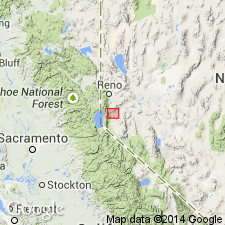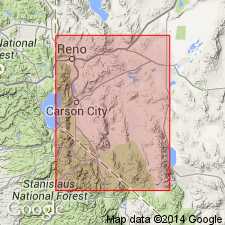
- Usage in publication:
-
- Santiago Canyon Tuff*
- Modifications:
-
- Named
- Reference
- Dominant lithology:
-
- Tuff
- AAPG geologic province:
-
- Great Basin province
Summary:
Named for Santiago Canyon. Type section: exposures at mouth of Santiago Canyon, NW/4 sec.5 T15N R21E, New Empire 7.5' quad, NV. Reference sections: 1) Hackett Canyon sec.9 T15N R21E, New Empire 7.5' quad, 2) hill in W/2 NE/4 sec.20 T16N R20E, Virginia Range, Carson City 7.5' quad, NV. Is simple cooling unit of gray-white to gray sphene-bearing hornblende-biotite quartz latite crystal-vitric tuff. Is over 300 m thick. Disconformably overlies older Tertiary tuffs or unconformably overlies Mesozoic rocks; unconformably underlies Alta Formation. Is late Oligocene or early Miocene age.
Source: GNU records (USGS DDS-6; Menlo GNULEX).

- Usage in publication:
-
- Santiago Canyon Tuff*
- Modifications:
-
- Geochronologic dating
- Age modified
- AAPG geologic province:
-
- Great Basin province
Summary:
Santiago Canyon Tuff. Sample from Carson City area, Lat. 39 deg. 10 min. 33 sec. N., Long 119 deg. 38 min. 11 sec. W., in NE/4 SW/4 sec. 9, T. 15 N., R. 21 E., New Empire 7.5-min quadrangle, Nevada, yielded K-Ar ages of 22.8 +/-0.7 Ma (biotite) and 21.6 +/-0.9 Ma (sanidine). Age is Miocene.
Source: GNU records (USGS DDS-6; Menlo GNULEX).
For more information, please contact Nancy Stamm, Geologic Names Committee Secretary.
Asterisk (*) indicates published by U.S. Geological Survey authors.
"No current usage" (†) implies that a name has been abandoned or has fallen into disuse. Former usage and, if known, replacement name given in parentheses ( ).
Slash (/) indicates name conflicts with nomenclatural guidelines (CSN, 1933; ACSN, 1961, 1970; NACSN, 1983, 2005, 2021). May be explained within brackets ([ ]).

